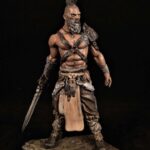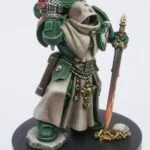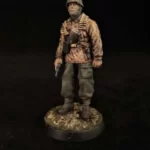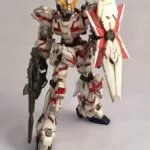How to Paint Miniature Leather and Lace
Want to learn how to paint realistic leather and lace textures on your miniatures? A quick way mini painters build up natural transitions for leather and lace effect is by dry brushing paint on the model. Still, there are other alternatives than that.
In this guide, we will show you how to paint leather and lace with three different techniques; contrast, shading, and stippling.
Introduction to Painting Miniature Leather and Lace
The method of painting leather and lace are quite similar. The only difference is the type of color you use.
Technically, you can use every color you use on leather to paint lace, whether beige or grey and light soft brown, which gives a boney hue to create that lacey or cotton vibe you need. Still, you want to ensure that when using these paints, you end your miniature painting sessions by applying a matte varnish to remove the sheen.
Ending with a shiny highlight will work perfectly for leather but won’t be such a good idea on lace since lace fabrics have a less reflective surface.
Want to learn more about painting leather? Check out our article on “How to paint Leather and Fur.”
Painting Miniature Leather and Lace: Shading Technique
Note: All through this guide, we use the Citadel’s contrast, shade, and layer paints.
For this step, start by applying a brown basecoat. Consider GW’s Skrag Brown for your model. Next, mix, on your palate, one part Nuln oil, three parts Seraphim Sepia, Agrax Earthshade, and Lahmian Medium.
You don’t want your mixture to come out too thick when applied on the leather or clothing surface. So, use a size 4 brush to help you apply paint quickly and lightly. Also, make sure the paint doesn’t pool. Do three to four layers of this mixture to build more depth for your leather textures. Then, let it dry.
Painting Miniature Leather and Lace: Contrast Technique
To start with, basecoat the leather or lace with GW’s Grey Seer Contrast paint. When it dries, get white paint (it doesn’t matter from which brand) and drybrush it all over the leather.
Most painters only highlight raised edges when dry brushing their miniatures, but this step helps you enhance the texture of the basecoat. Plus, after this step, you will also apply some texture-based highlights on the raised parts of the model so that you don’t have to worry about ending with a flat or dull texture at the end of the day.
Next, water down a small amount of Balor Brown to cover the white paint. Once it dries, apply a coat of Lahmian medium for wash effects and move on to highlighting your leather and lace textures.
Here, we do a 50/50 mix of Skrag brown and Averland Sunset to create warm leather texture effects. Work off the excesses on your paintbrush and softly drybrush over the raised parts of your leather and lace textures, and you’re done!
If, like many painters, you want something extra to create wear and tear, and enhance the reflection of light on the raised edges, do a 50/50 mix of Skrag Brown and Balor Brown (Tausepet Ochre) and paint it randomly over the raised edges. Then, apply a final highlight with the Tausepet Ochre.
Painting Miniature Leather and Lace: Stippling Technique
First things first, base coat the miniature with Abaddon Black. After it dries, do a 50.50 mix of Abaddon black and Doombull Brown and paint it over the leather surface. Make sure it doesn’t come off too thick or too thin so that painting the other layers won’t be a hassle.
With your large yet stiff brush, dip it into your pure Doombull brown color and start stippling randomly over the previous coat so that the result looks like large dotted shapes scattered all over the leather surface. Do two more layers to achieve a dark leathery color.
Thin down your Skrag brown paint. Then drybrush it all over the stippled coat to soften the paint color and create a natural transition from black to brown.
Do a 50/60 mix of GW’s Deathclaw layer paint with Skrag Brown and apply softly over the previous coat. When applying this highlight, concentrate more on the edges to ensure it settles well and comes out as you want.
As a final highlight, do a 50/50 mix of your pure Death Claw and Screaming Skull paints. Then, stipple it over the raised edges to enhance the light effect.
Conclusion
Painting leather and lace is one of the easiest tricks mini painters can master in a short time. All you need to do is determine the type of leather or lace you wish to create on your miniature. Whether you choose the contrast, shade, or stippling technique, the good news is that you can end up with a pretty similar level of highlights and realistic results, even though they require different procedures.





